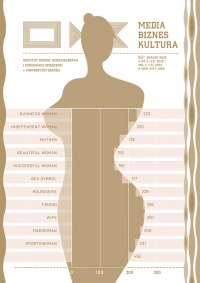Image of Women in Advertising. Research report
Keywords:
advertising, stereotype, woman, image, femvertisingAbstract
Women are mainly responsible for making purchasing decisions, which makes them a key group for advertisers. Reaching them with a message requires creating an appropriate advertising insight and an image of a woman attractive to the recipients. When discussing ad creations, one speaks of femvertising, women’s empowerment, equality, as well as stereotyping, depreciation and sexism. In order to verify the opinions on the image of women in advertising, the author conducted an analysis of advertising communication of selected Polish and international companies. 1045 audio-video advertisements (5 campaigns of 209 brands each) were examined. The aim was to show what types of female images dominate in advertising. Ten areas were examined, including: female attributes, external appearance, phase of the family cycle, the protagonist’s surroundings, female self, the brand’s promise, the protagonist’s emotions, relations with men and the narrator in the advertisement. The results of the analysis showed that advertisers, seeing the growing aspirations of women, no longer show them only as mothers, housewives or lovers. More often they build their internal strength, expressive identity, subjectivity, self-determination and independence, as well as personal development and fulfillment of dreams. At the same time, they provide their heroines with a wide range of opportunities not only for family, maternal and emotional but also professional, sports, property and passion development.
Downloads
References
Monografie
Bator J., Wizerunek kobiety w reklamie telewizyjnej, Wydawnictwo Instytutu Spraw Publicznych, Warszawa 1988.
Dąbała J., Horyzonty komunikacji medialnej, Wydawnictwo Uniwersytetu Marii Curie- -Skłodowskiej, Lublin 2006.
Doliński D., Psychologiczne mechanizmy reklamy, Gdańskie Wydawnictwo Psychologiczne, Gdańsk 2008.
Durys E., Ostrowska E., Gender. Wizerunki kobiet i mężczyzn w kulturze, Rabid, Kraków 2005.
Środa M., Kobiety i władza, W.A.B, Warszawa 2012.
Rozdziały z książek
Grzegorzewska K.M., Wizerunek kobiety w reklamie [w:] Kobieta we współczesnym, red. J. Mazur-Łuczak, Wydawnictwo Wyższej Szkoły Biznesu, Gorzów Wielkopolski 2012.
Artykuły z czasopism
Chung-Kue J., Femvertising, state of art, „Journal of Brand Strategy” 2018, nr 7(28–48), s. 32.
Ciochetto, L., Images of women in advertising both consumer and object of consumption. „Media Asia” 2008, nr 35(4), s. 241–249.
Drake V.E., The impact of Female Empowerment in Advertising (Femvertising), „Journal of Research in Marketing” 2017, nr 7(3), s. 593.
Kitlińska E., Maison D., Strzałka A., Pawlikowska K., Płeć konsumenta w marketingu – komunikat z badań internetowych w „Kobieta i Biznes”, Kolegium Gospodarki Światowej, SGH, Warszawa 1–4.2010, s. 14.
Kończak J., An image of a man in a sports advertisement, „Quality in Sport”, 28.06.2022, t. 7, nr 3, s. 14–27.
Kończak J., An image of a woman in a sports advertisement, „Journal of Education, Health and Sport”, t. 12, nr 5, s. 215–230.
Macias K., Femvertising and Its Perception by Polish Female Consumers, „Journal of Marketing and Consumer Behaviour in Emerging Markets” 2021, nr 1(12), s. 55, 69.
Rajagopal, I., Gales J., It’s the image that is imperfect: Advertising and its impact on women, „Economic and Political Weekly” 2002, nr 37(32), s. 3333–3337.
Rudzewicz A., Grzybowska-Brzezińska M., Wojtkowska A., Wizerunek kobiety w reklamie internetowej w zależności od płci adresatów przekazu, „Handel Wewnętrzny” 2015, nr 1(354), s. 231–240.
Teng F., Hu J., Chen Z., Poon K.T., Bai, Y., Sexism and the Effectiveness of Femvertising in China: A Corporate Social Responsibility Perspective. „Sex Roles. A Journal of Research” 2020, nr 84(5–6), s. 253–270.
Varghese N., Kumar N., Feminism in advertising: irony or revolution? A critical review of femvertising, „Feminist Media Studies” 29.09.2020, s. 441–459.
Raporty
Budżety domowe Polaków, ARC Rynek i Opinia, 03.2016.
Mindshare Polska, Zakupy w polskich domach – kto decyduje, a kto kupuje?, 2019.
Sprawozdania Komisji Etyki w Reklamie (2008–2018). Źródła internetowe Epidemia otyłości w Europie. Prawie 60 procent dorosłych, https://www.dw.com/pl/epidemiaotyłości-w-europie-prawie-60-procent-dorosłych/a-61675266 (dostęp: 5.09.20222).
Gillespie C, #Femvertising 2016: Why don’t men care more about sexualized women in ads?, https://www.sheknows.com/living/articles/1128576/femvertising-awards-survey-results/ (dostęp: 15.11.2022).
Goczał B., Kobiety w reklamach przedstawiane coraz nowocześniej, chociaż krzywdzące stereotypy są nocne (opinie), https://www.wirtualnemedia.pl/artykul/kobiety-w-reklamachjak-pokazywane-stereotypy-nadal-mocne-8-marzec-dzien-kobiet (dostęp: 1.09.2022).
Marketing kobiecy – dopiero trend, już standard czy walka ze stereotypami, https://www.wirtualnemedia.pl/artykul/marketing-kobiecy-dopiero-trend-czy-juz-standard?fbclid= IwAR2xoC3q52lfwUQa1OdF6CkZ0PaGvbTiDPqnxhli93C0kZi2qvnuYzgP-g8 (dostęp: 7.09.2022).
Raport. Płeć Konsumenta w marketingu, http://www.marketingkobiet.pl/raport-plec-konsumenta/ (dostęp: 2.09.2022).
Stawikowska E., Przyszłość kobiet w rękach i głowach kobiet. Womennomics nabiera na sile i znaczeniu. https://www.forbes.pl/biznes/kobiety-podejmuja-nawet-80-procent-decyzjizakupowych-jaka-jest-konsumentka-xxi-wieku/r5b6l7x (dostęp: 2.09.2022).
UNESCO in action for gender equality, 2020–2021, https://unesdoc.unesco.org/ark:/48223/pf0000380680 (dostęp: 5.09.2022)

 Academic Scientific Journals
Academic Scientific Journals




